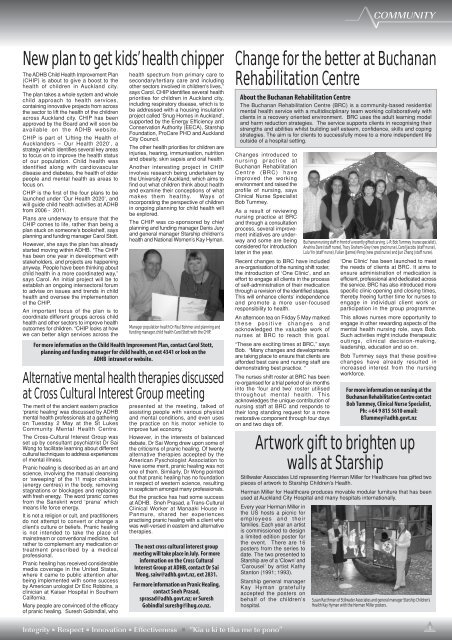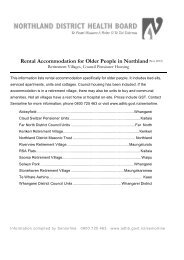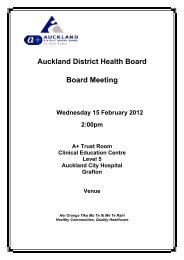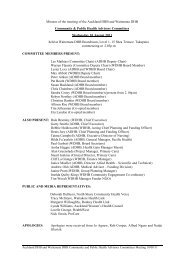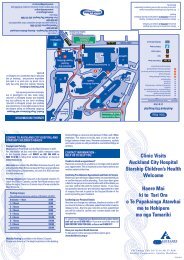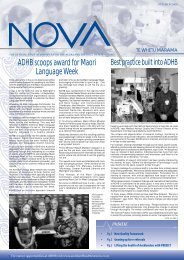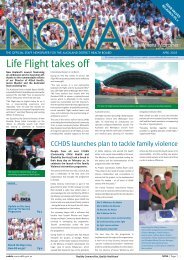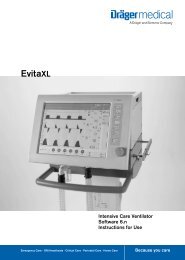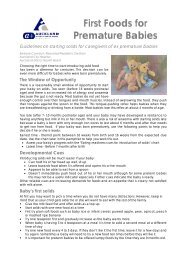NOVA - June.fh9 copy - Auckland District Health Board
NOVA - June.fh9 copy - Auckland District Health Board
NOVA - June.fh9 copy - Auckland District Health Board
You also want an ePaper? Increase the reach of your titles
YUMPU automatically turns print PDFs into web optimized ePapers that Google loves.
New plan to get kids’ health chipper<br />
The ADHB Child <strong>Health</strong> Improvement Plan<br />
(CHIP) is about to give a boost to the<br />
health of children in <strong>Auckland</strong> city.<br />
The plan takes a whole system and whole<br />
child approach to health services,<br />
containing innovative projects from across<br />
the sector to lift the health of the children<br />
across <strong>Auckland</strong> city. CHIP has been<br />
approved by the <strong>Board</strong> and will soon be<br />
available on the ADHB website.<br />
CHIP is part of ‘Lifting the <strong>Health</strong> of<br />
<strong>Auckland</strong>ers – Our <strong>Health</strong> 2020’, a<br />
strategy which identifies several key areas<br />
to focus on to improve the health status<br />
of our population. Child health was<br />
identified along with cardiovascular<br />
disease and diabetes, the health of older<br />
people and mental health as areas to<br />
focus on.<br />
CHIP is the first of the four plans to be<br />
launched under ‘Our <strong>Health</strong> 2020’, and<br />
will guide child health activities at ADHB<br />
from 2006 - 2011.<br />
Plans are underway to ensure that the<br />
CHIP comes to life, rather than being a<br />
plan stuck on someone’s bookshelf, says<br />
planning and funding manager Carol Stott.<br />
However, she says the plan has already<br />
started moving within ADHB. “The CHIP<br />
has been one year in development with<br />
stakeholders, and projects are happening<br />
anyway. People have been thinking about<br />
child health in a more coordinated way,”<br />
says Carol. An initial project will be to<br />
establish an ongoing intersectoral forum<br />
to advise on issues and trends in child<br />
health and oversee the implementation<br />
of the CHIP.<br />
An important focus of the plan is to<br />
coordinate different groups across child<br />
health and other sectors to improve health<br />
outcomes for children. “CHIP looks at how<br />
we can better align services across the<br />
The merit of the ancient eastern practice<br />
‘pranic healing’ was discussed by ADHB<br />
mental health professionals at a gathering<br />
on Tuesday 2 May at the St Lukes<br />
Community Mental <strong>Health</strong> Centre.<br />
The Cross-Cultural Interest Group was<br />
set up by consultant psychiatrist Dr Sai<br />
Wong to facilitate learning about different<br />
cultural techniques to address experiences<br />
of mental illness.<br />
Pranic healing is described as an art and<br />
science, involving the manual cleansing<br />
or ‘sweeping’ of the 11 major chakras<br />
(energy centres) in the body, removing<br />
stagnations or blockages and replacing<br />
with fresh energy. The word ‘pranic’ comes<br />
from the Sanskrit word ‘prana’ which<br />
means life force energy.<br />
It is not a religion or cult, and practitioners<br />
do not attempt to convert or change a<br />
client’s culture or beliefs. Pranic healing<br />
is not intended to take the place of<br />
mainstream or conventional medicine, but<br />
rather to complement any medication or<br />
treatment prescribed by a medical<br />
professional.<br />
Pranic healing has received considerable<br />
media coverage in the United States,<br />
where it came to public attention after<br />
being implemented with some success<br />
by American urologist Dr Eric Robbins, a<br />
clinician at Kaiser Hospital in Southern<br />
California.<br />
Many people are convinced of the efficacy<br />
of pranic healing. Suresh Gobindlal, who<br />
health spectrum from primary care to<br />
secondary/tertiary care and including<br />
other sectors involved in children's lives,”<br />
says Carol. CHIP identifies several health<br />
priorities for children in <strong>Auckland</strong> city,<br />
including respiratory disease, which is to<br />
be addressed with a housing insulation<br />
project called 'Snug Homes in <strong>Auckland</strong>',<br />
supported by the Energy Efficiency and<br />
Conservation Authority (EECA), Starship<br />
Foundation, ProCare PHO and <strong>Auckland</strong><br />
City Council.<br />
The other health priorities for children are<br />
injuries, hearing, immunisation, nutrition<br />
and obesity, skin sepsis and oral health.<br />
Another interesting project in CHIP<br />
involves research being undertaken by<br />
the University of <strong>Auckland</strong>, which aims to<br />
find out what children think about health<br />
and examine their conceptions of what<br />
makes them healthy. Ways of<br />
incorporating the perspective of children<br />
in ongoing planning for child health will<br />
be explored.<br />
The CHIP was co-sponsored by chief<br />
planning and funding manager Denis Jury<br />
and general manager Starship children’s<br />
health and National Women’s Kay Hyman.<br />
Manager population health Dr Paul Bohmer and planning and<br />
funding manager, child health Carol Stott with the CHIP.<br />
For more information on the Child <strong>Health</strong> Improvement Plan, contact Carol Stott,<br />
planning and funding manager for child health, on ext 4341 or look on the<br />
ADHB intranet or website.<br />
Alternative mental health therapies discussed<br />
at Cross Cultural Interest Group meeting<br />
presented at the meeting, talked of<br />
assisting people with various physical<br />
and mental conditions, and even uses<br />
the practice on his motor vehicle to<br />
improve fuel economy.<br />
However, in the interests of balanced<br />
debate, Dr Sai Wong drew upon some of<br />
the criticisms of pranic healing. Of twenty<br />
alternative therapies accepted by the<br />
American Pyschologist Association to<br />
have some merit, pranic healing was not<br />
one of them. Similarly, Dr Wong pointed<br />
out that pranic healing has no foundation<br />
in respect of western science, resulting<br />
in scepticism amongst many professionals.<br />
But the practice has had some success<br />
at ADHB. Sneh Prasad, a Trans-Cultural<br />
Clinical Worker at Manaaki House in<br />
Panmure, shared her experiences<br />
practising pranic healing with a client who<br />
was well-versed in eastern and alternative<br />
therapies.<br />
The next cross cultural interest group<br />
meeting will take place in July. For more<br />
information on the Cross Cultural<br />
Interest Group at ADHB, contact Dr Sai<br />
Wong, saiw@adhb.govt.nz, ext 2831.<br />
For more information on Pranic Healing,<br />
contact Sneh Prasad,<br />
sprasad@adhb.govt.nz; or Suresh<br />
Gobindlal sureshg@ihug.co.nz.<br />
Changes introduced to<br />
nursing practice at<br />
Buchanan Rehabilitation<br />
Centre (BRC) have<br />
improved the working<br />
environment and raised the<br />
profile of nursing, says<br />
Clinical Nurse Specialist<br />
Bob Tummey.<br />
As a result of reviewing<br />
nursing practice at BRC<br />
and through a consultation<br />
process, several improvement<br />
initiatives are underway<br />
and some are being<br />
considered for introduction<br />
later in the year.<br />
Recent changes to BRC have included<br />
a re-organisation of the nursing shift roster,<br />
the introduction of ‘One Clinic’, and an<br />
effort to engage all clients in the process<br />
of self-administration of their medication<br />
through a revision of the identified stages.<br />
This will enhance clients’ independence<br />
and promote a more user-focused<br />
responsibility to health.<br />
An afternoon tea on Friday 5 May marked<br />
these positive changes and<br />
acknowledged the valuable work of<br />
nurses at BRC to reach this goal.<br />
“These are exciting times at BRC,” says<br />
Bob. “Many changes and developments<br />
are taking place to ensure that clients are<br />
afforded best care and nursing staff are<br />
demonstrating best practice. “<br />
The nurses shift roster at BRC has been<br />
re-organised for a trial period of six months<br />
into the ‘four and two’ roster utilised<br />
throughout mental health. This<br />
acknowledges the unique contribution of<br />
nursing staff at BRC and responds to<br />
their long standing request for a more<br />
restorative component through four days<br />
on and two days off.<br />
Integrity Respect Innovation Effectiveness “Kia u ki te tika me te pono”<br />
COMMUNITY<br />
Change for the better at Buchanan<br />
Rehabilitation Centre<br />
About the Buchanan Rehabilitation Centre<br />
The Buchanan Rehabilitation Centre (BRC) is a community-based residential<br />
mental health service with a multidisciplinary team working collaboratively with<br />
clients in a recovery oriented environment. BRC uses the adult learning model<br />
and harm reduction strategies. The service supports clients in recognising their<br />
strengths and abilities whilst building self esteem, confidence, skills and coping<br />
strategies. The aim is for clients to successfully move to a more independent life<br />
outside of a hospital setting.<br />
‘One Clinic’ has been launched to meet<br />
the needs of clients at BRC. It aims to<br />
ensure administration of medication is<br />
efficient, professional and dedicated across<br />
the service. BRC has also introduced more<br />
specific clinic opening and closing times,<br />
thereby freeing further time for nurses to<br />
engage in individual client work or<br />
participation in the group programme.<br />
This allows nurses more opportunity to<br />
engage in other rewarding aspects of the<br />
mental health nursing role, says Bob.<br />
Such activities might include therapeutic<br />
outings, clinical decision-making,<br />
leadership, education and so on.<br />
Bob Tummey says that these positive<br />
changes have already resulted in<br />
increased interest from the nursing<br />
workforce.<br />
Artwork gift to brighten up<br />
walls at Starship<br />
Stillwater Associates Ltd representing Herman Miller for <strong>Health</strong>care has gifted two<br />
pieces of artwork to Starship Children’s <strong>Health</strong>.<br />
Herman Miller for <strong>Health</strong>care produces movable modular furniture that has been<br />
used at <strong>Auckland</strong> City Hospital and many hospitals internationally.<br />
Every year Herman Miller in<br />
the US hosts a picnic for<br />
employees and their<br />
families. Each year an artist<br />
is commissioned to design<br />
a limited edition poster for<br />
the event. There are 16<br />
posters from the series to<br />
date. The two presented to<br />
Starship are of a ‘Clown’ and<br />
‘Carousel’ by artist Kathy<br />
Stanton (1991; 1993).<br />
Starship general manager<br />
Kay Hyman gratefully<br />
accepted the posters on<br />
behalf of the children’s<br />
hospital.<br />
Buchanan nursing staff in front of a recently gifted carving. L-R: Bob Tummey (nurse specialist),<br />
Anahira Dare (staff nurse), Tracy Graham-Grey (new grad nurse), Carol Jacobs (staff nurse),<br />
Lulu Yin (staff nurse), Fulian (James) Peng (new grad nurse) and Jun Zhang (staff nurse).<br />
For more information on nursing at the<br />
Buchanan Rehabilitation Centre contact<br />
Bob Tummey, Clinical Nurse Specialist,<br />
Ph: +64 9 815 5610 email:<br />
BTummey@adhb.govt.nz<br />
Susan Racthman of Stillwater Associates and general manager Starship Children’s<br />
<strong>Health</strong> Kay Hyman with the Herman Miller posters.<br />
5


